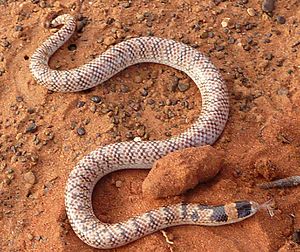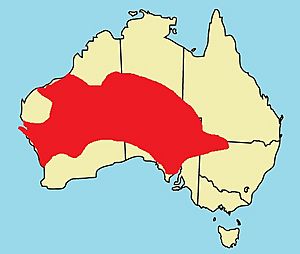Brachyurophis fasciolatus facts for kids
Quick facts for kids Brachyurophis fasciolatus |
|
|---|---|
 |
|
| Conservation status | |
| Scientific classification | |
 |
|
| Synonyms | |
|
Rhinelaps fasciolatus, Rhynchoelaps fasciolatus, Simoselaps fasciolatus |
The Brachyurophis fasciolatus is a type of snake from the Elapidae family. It is often called the narrow-banded shovel-nosed snake or narrow-banded burrowing snake. This snake is special because it is found only in Australia. Its common names tell us about its shovel-like nose, how it burrows (digs), and the bands on its body.
Contents
About This Snake
The narrow-banded shovel-nosed snake is usually about 30 cm (12 in) long. It can grow up to 40 cm (16 in) in total length. You can tell this snake apart from others in its group by looking at its scales. It has a special scale between its preocular and nasal scales. Other snakes in this group have these two scales touching.
The belly of this snake is cream or white. It has about 140 to 175 belly scales. It also has 15 to 30 scales under its tail, which are split. The scale near its vent (anal scale) is also split.
The top of the snake is brightly colored. It has a pale reddish-brown or cream background. There are more than 50 narrow bands across its body. These bands are made of scales with black tips, giving the snake its striped look. Its snout (nose area) is light, either cream or brown. The head is black, with a thin lighter band that splits the black head and neck into two parts. On average, it has 17 rows of scales around the middle of its body.
Snake Family Tree
Brachyurophis fasciolatus is one of eight types of snakes in the Brachyurophis group. There are also two subspecies: Brachyurophis fasciolatus fasciatus and Brachyurophis fasciolatus fasciolatus.
This snake was first named Rhinelaps fasciolatus by Günther in 1872. Over the years, its name changed several times. In the early 2000s, it was finally placed into the Brachyurophis group. Other names it used to have include Rhinelaps fasciolatus (Günther 1872), Rhynchoelaps fasciolatus (Boulenger 1896), and Simoselaps fasciolatus (Cogger 1983).
Where It Lives
The Brachyurophis fasciolatus snake lives all over mainland Australia. It is not found in Victoria. You can find it in dry areas and near the coast. The subspecies B. fasciolatus fasciolatus lives in Western Australia. The B. fasciolatus fasciatus subspecies is found in central Australia.
Experts say this snake is of "Least Concern" globally. This means it is not currently at high risk of disappearing. However, in New South Wales, it is listed as "Vulnerable."
This snake likes to burrow (dig) in sandy places. It prefers slopes and hilltops. Its home can be in savannas, deserts, grasslands, and shrubland areas. This includes sandy dunes with spinifex grass.
How It Behaves
The narrow-banded shovel-nosed snake is active at night. It is a burrowing snake, meaning it spends a lot of time digging in sandy soil. On warm nights, it comes out to the surface to find food.
These snakes reproduce by laying eggs. They usually lay three to five eggs at a time. The eggs are laid in late spring to early summer. The baby snakes hatch from late summer to early autumn (January to March).
What It Eats
The narrow-banded burrowing snake hunts on the surface for small lizards and their eggs. It seems to prefer small, slender skinks and their eggs. Two types of skinks it likes to eat are Lerista and Ctenotus. These skinks are often long and thin. They also live in similar sandy, burrowing habitats.
The Brachyurophis fasciolatus is a venomous snake. However, its venom is generally considered mild for humans.
*Note: All snake bites should be treated as serious, even if the snake's venom is mild.
Dangers to the Snake
Experts believe there are not many threats to this snake. This is because it lives in large areas where not many people live. In New South Wales, it lives in a small part of its total range. Here, the main threats are habitat loss and damage to the soil. This damage can come from animals like cattle and from farming.
We don't have much information on specific animals that hunt this snake. However, other snakes and birds probably eat them if they get the chance.
See also
 In Spanish: Brachyurophis fasciolatus para niños
In Spanish: Brachyurophis fasciolatus para niños


